Today, all eligible members of the LGBTQ+ community are allowed to serve in America’s military. However, it hasn’t always been that way. The treatment of queer people in the armed forces has a fraught history—until the 1990s, military personnel could be discharged for homosexuality, and until 2010, gay, lesbian, and bisexual servicemembers had to keep their sexuality a secret. Transgender people weren’t allowed to openly serve until 2016. In honor of Pride Month, let’s use HeinOnline to take a look at the history of queer representation in America’s armed forces. Particularly, there’s a whole subcollection of our LGBTQ+ Rights database dedicated to Military Service, which explores policies like Don’t Ask, Don’t Tell.
Revolutionary Through World Wars
Homosexual activity was grounds for discharge from the armed services from as early as the Revolutionary War. But LGBTQ+ people weren’t explicitly barred from military service until after World War I, when homosexuality was labeled in psychiatry as a mental or behavioral disorder. Psychiatric screenings were added to the induction process for servicemembers, and therefore those who were gay, lesbian, or bisexual were disqualified from entering service. Sodomy was listed as a crime punishable by court-martial.[1]1976 Edition, v.2 Titles 8-11 276 (1976 ), Sections 923 – 926. This document can be found in HeinOnline’s U.S. Code database. By 1942, homosexuality was officially listed as a disqualifying factor for entering into the armed forces. Those who engaged in homosexual acts could be dishonorably discharged from the military.[2]NSIAD-92-98S 24 (1992-06-12). Defense Force Management: Statistics Related To Dod’s Policy On Homosexuality. This document can be found in HeinOnline’s GAO Reports and Comptroller General Decisions database.
In 1957, the Crittenden Report,[3]NSIAD-92-98S 24 (1992-06-12). Defense Force Management: Statistics Related To Dod’s Policy On Homosexuality. This document can be found in HeinOnline’s GAO Reports and Comptroller General Decisions database. part of an investigation of the a board created for the Revision of Policies, Procedures and Directives Dealing With Homosexuals in the navy, found that there was “no sound basis for the belief that homosexuals posed a security risk.” Regardless, no suggestions were made for allowing gay men into the armed forces.
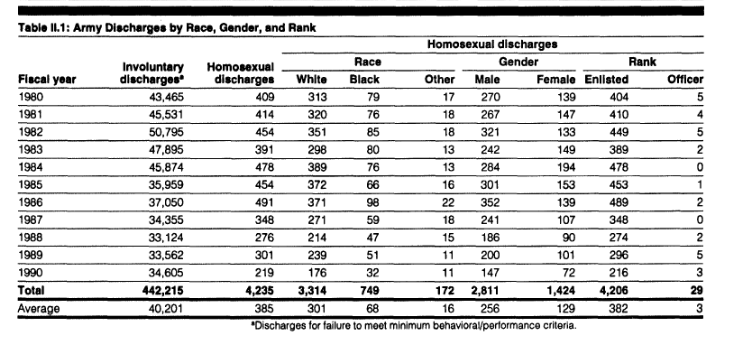
The Military and the Gay Rights Movement
One of the issues addressed during the Gay and Lesbian Rights Movement of the 1970s and 1980s was military discrimination. Air Force Technical Sergeant Leonard Matlovich[4]Paula Hepner, Out of the Closets, into the Courtrooms, 4 STUDENT LAW. 34 (1975). This article can be found in HeinOnline’s Law Journal Library. became the first person to openly come out to the military in protest of the ban in 1975, and he was subsequently discharged after refusing to sign a pledge to never engage in homosexuality again, despite the fact that he had an exceptional military record. Matlovich proceeded to sue for reinstatement and appeared on the cover of Time magazine’s September 8, 1975 issue that year because of his advocacy, showcasing him in his AirForce uniform with the headline “I Am a Homosexual: The Gay Drive for Acceptance.” However, the Department of Defense reaffirmed the ban on LGBTQ+ people in the military in 1981, stating that “Homosexuality is incompatible with military service,” and approximately 17,000 service members were discharged for homosexuality in the 1980s.[5]NSIAD-92-98S 24 (1992-06-12). Defense Force Management: Statistics Related To Dod’s Policy On Homosexuality. This document can be found in HeinOnline’s GAO Reports and Comptroller General Decisions database.
Homosexuality is incompatible with military service. The presence in the military
environment of persons who engage in homosexual conduct or who, by their statements,
demonstrate a propensity to engage in homosexual conduct, seriously impairs the
accomplishment of the military mission. The presence of such members adversely affects
the ability of the Military Services to maintain discipline, good order, and morale; to foster
mutual trust and confidence among servicemembers; to ensure the integrity of the system
of rank and command; to facilitate assignment and worldwide deployment of
servicemembers who frequently must live and work under close conditions affording
minimal privacy; to recruit and retain members of the Military Services; to maintain public
acceptability of military service; and to prevent breaches of security.
The following graphs can be found in the document Defense Force Management, Dod’s Policy on Homosexuality, located within our LGBTQ+ Rights database.
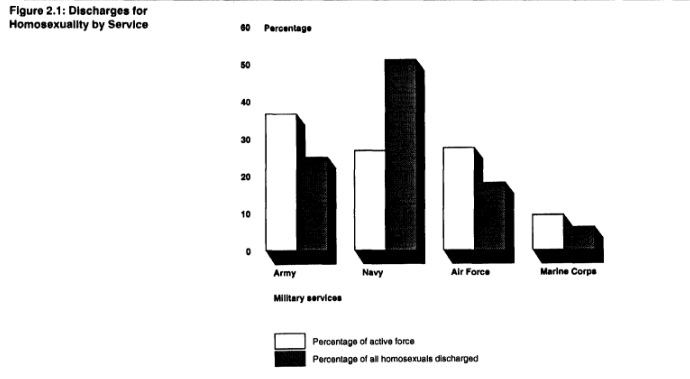
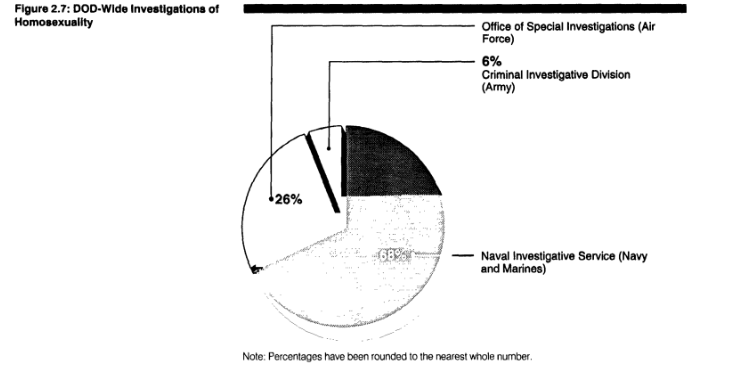
The DADT Compromise
In the 1992 presidential election, Democratic candidate Bill Clinton campaigned on ending the military’s ban of homosexual servicemembers. But due to opposition in Congress and among military leaders, open acceptance of the LGBTQ+ community into the armed forces wasn’t likely to happen. In 2014, the Clinton Library released notes from a conversation with Colin Powell, who at the time was chairman of the Joint Chiefs of Staff, which suggest that Powell offered that a “possible solution” would be that “we stop asking.”
Thus, the policy known as “Don’t Ask, Don’t Tell” was introduced by Clinton in 1993 as a compromise. The statute states that, while open acceptance of homosexuality in the military “would create an unacceptable risk to the high standards of morale, good order and discipline, and unit cohesion that are the essence of military capability,”[6][ii] (September 2, 2009) Don’t Ask, Don’t Tell: A Legal Analysis. This document can be found in HeinOnline’s U.S. Congressional Documents database. closeted LGBTQ+ servicemembers would now be accepted into the military. Military personnel would not ask about the sexual orientation of fellow servicemembers, and homosexual servicemembers could not disclose their sexual orientation or any same-sex relationships without facing the risk of discharge. Clinton admitted that the law was “not a perfect solution” but claimed that it was a “major step forward.”[7]William J. Clinton, Remarks Announcing the New Policy on Homosexuals in the Military – July 19, 1993, 1993 Pub. Papers 1109 (1993). This document can be found in HeinOnline’s U.S. Presidential Library database. The policy passed as Clinton’s Defense Directive 1304.26. However, there was mounting criticism that the law only perpetuated discrimination against the LGBTQ+ community—they were welcome to serve, but they were not welcome to be themselves.
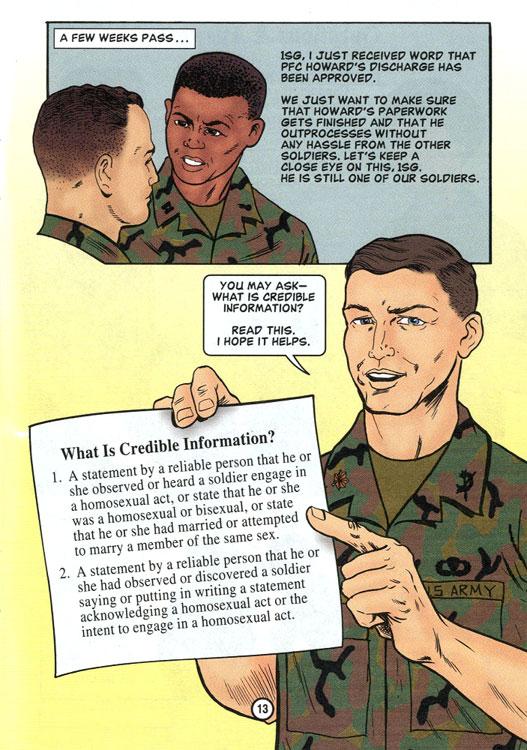
Fighting for Full Acceptance
The Don’t Ask, Don’t Tell policy faced several legal challenges. The Supreme Court in the case Bowers v. Hardwick (1986)[8]Bowers, Attorney General of Georgia v. Hardwick et al. , 478 U.S. 186, 220 (1986). This case can be found in HeinOnline’s U.S. Supreme Court Library. had ruled that there is no inherent right to consensual homosexual relations. This case was ultimately overruled in Lawrence v. Texas (2003),[9]Lawrence et al. v. Texas, 539 U.S. 558, 606 (2003). This case can be found in HeinOnline’s U.S. Supreme Court Library. which determined that laws prohibiting gay sex were unconstitutional. In Log Cabin Republicans v. United States (2011),[10]Log Cabin Republicans v. United States, 658 F.3d 1162 (9th Cir. 2011). This case can be found in Fastcase. a federal district court ruled Don’t Ask, Don’t Tell unconstitutional, and another federal district court ruled similarly in Witt v. United States Department of the Air Force (2008).[11]Witt, et al v. Dept of Air Force, et al, No. 06-35644 (9th Cir. 2008). This case can be found in Fastcase.
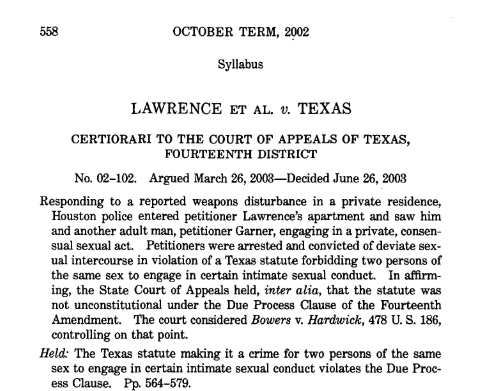
Public opinion also began to turn toward repealing Don’t Ask, Don’t Tell,[12]Pamela Lundquist, Essential to the National Security: An Executive Ban on Don’t Ask, Don’t Tell, 16 AM. U. J. GENDER SOC. POL’y & L. 115 (2007). This article can be found in HeinOnline’s … Continue reading especially after the terrorist attacks of September 11, 2001. As the United States entered war with Iraq and Afghanistan, support began to wane for discharging openly gay servicemembers—more than 13,000 troops were discharged for homosexuality between the time that Don’t Ask, Don’t Tell was enacted and 2009.
In 2008, Democratic presidential candidate Barack Obama campaigned on the promise of fulling repealing Don’t Ask, Don’t Tell and allowing openly LGBTQ+ troops in the armed forces.
Repeal and Recognition
In 2010, the Pentagon released a report[13]282 (2011) The report of the Department of Defense working group that conducted a comprehensive review of the issues associated with a repeal of section 654 of Title 10, U.S.C., “Policy concerning homosexuality in the armed forces” : … Continue reading that showed that 70% of service members believed that a repeal would have mixed, positive, or no impact on the armed forces. At the end of the year, the repeal of the Don’t Ask, Don’t Tell policy[14]124 Stat. 3515 (2010) (2010). This document can be found in HeinOnline’s U.S. Statutes at Large database. passed both the House and Senate, and Obama signed it into law on December 22, 2010.
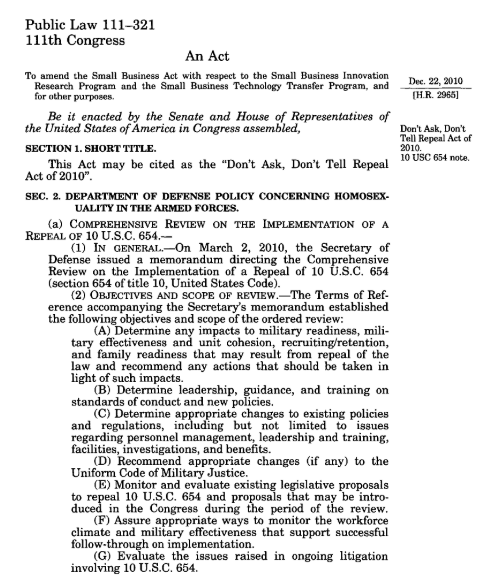
Openly LGBTQ+ people could now serve in the U.S. military. The Department of Defense for the first time allowed military personnel to wear their uniforms to participate in a gay pride event, the 2012 San Diego Pride Parade.
In 2013, the Pentagon announced that women would now be allowed to serve in ground-combat units,[15]Maria Brekke, Is It Just Dessert: Female Recruits Don’t Get Their Share of the Pie: The Marine Corps Fights Gender Integration of Basic Training, Violating Equal Protection Standards and Cultivating a Culture Where Female Marines Are Left out … Continue reading and in 2015, it added sexual orientation to the Military Equal Opportunity policy to protect queer servicemembers from discrimination.
Transgender People in the Military
In 2016, the ban on openly transgender servicemembers in the military was also ended. However, in 2017, then-President Trump tweeted: “After consultation with my Generals and military experts, please be advised that the United States Government will not accept or allow……….Transgender individuals to serve in any capacity in the U.S. Military. Our military must be focused on decisive and overwhelming………victory and cannot be burdened with the tremendous medical costs and disruption that transgender in the military would entail. Thank you[.]”[16][i] (July 26, 2017) Transgender Servicemembers: Policy Shifts and Considerations for Congress. This document can be found in HeinOnline’s U.S. Congressional Documents database. In March 2018, he signed a memorandum[17]Memorandum on Military Service by Transgender Individuals, Daily Comp. Pres. Docs. 1 (2018). This document can be found in HeinOnline’s Federal Register Library. barring some trans people from service. President Joe Biden repealed the ban[18]Executive Order 14004-Enabling All Qualified Americans to Serve Their Country in Uniform, Daily Comp. Pres. Docs. 1 (2021). This document can be found in HeinOnline’s Federal Register Library. within his first month in office in January 2021.
Additionally, the federal government is currently considering expanding TRICARE, the program that offers health care benefits to servicemembers, veterans, and their dependent family members, to include coverage for gender-affirming care, such as hormone therapy, counseling, and gender-affirming surgery.[19]1 1 (January 4, 2024) FY2024 NDAA: TRICARE Coverage of Gender-Affirming Care. This document can be found in HeinOnline’s U.S. Congressional Documents database.
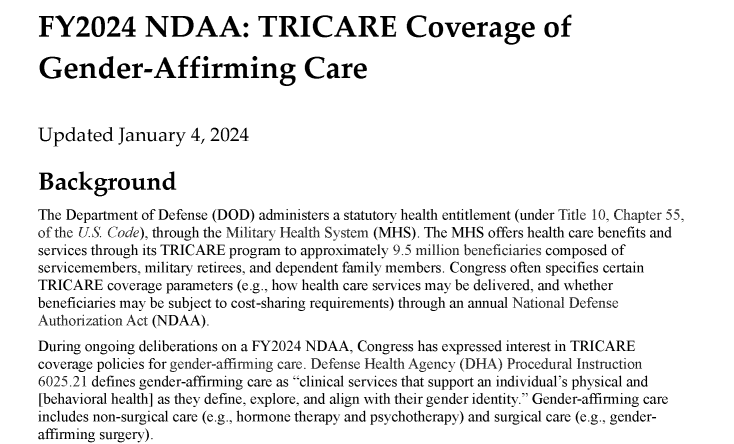
Continue Researching Pride with Our LGBTQ+ Rights Database
HeinOnline’s LGBTQ+ Rights database, part of our perpetually free Social Justice Suite, charts the gay rights movement in America, showing the civil rights codified into law in the 20th and 21st centuries, as well as the inequalities that still exist today. All titles in this collection are divided into six subcollections: Marriage and Family, Employment Discrimination, Military Service, AIDS and Health Care, and Public Spaces and Accommodations, and Historical Attitudes and Analysis, presents books, pamphlets, reports, and more from the 18th century through the mid-20th century. Additionally, this collection includes publications from UCLA School of Law’s Williams Institute, a leading research center on sexual orientation and gender identity law and public policy. This collection also includes scholarly articles, a bibliography, and a unique interactive timeline. Activate your access today to learn more about the LGBTQ+ pride movement and the rights this community has achieved and are still fighting for.
HeinOnline Sources[+]
| ↑1 | 1976 Edition, v.2 Titles 8-11 276 (1976 ), Sections 923 – 926. This document can be found in HeinOnline’s U.S. Code database. |
|---|---|
| ↑2, ↑3 | NSIAD-92-98S 24 (1992-06-12). Defense Force Management: Statistics Related To Dod’s Policy On Homosexuality. This document can be found in HeinOnline’s GAO Reports and Comptroller General Decisions database. |
| ↑4 | Paula Hepner, Out of the Closets, into the Courtrooms, 4 STUDENT LAW. 34 (1975). This article can be found in HeinOnline’s Law Journal Library. |
| ↑5 | NSIAD-92-98S 24 (1992-06-12). Defense Force Management: Statistics Related To Dod’s Policy On Homosexuality. This document can be found in HeinOnline’s GAO Reports and Comptroller General Decisions database. |
| ↑6 | [ii] (September 2, 2009) Don’t Ask, Don’t Tell: A Legal Analysis. This document can be found in HeinOnline’s U.S. Congressional Documents database. |
| ↑7 | William J. Clinton, Remarks Announcing the New Policy on Homosexuals in the Military – July 19, 1993, 1993 Pub. Papers 1109 (1993). This document can be found in HeinOnline’s U.S. Presidential Library database. |
| ↑8 | Bowers, Attorney General of Georgia v. Hardwick et al. , 478 U.S. 186, 220 (1986). This case can be found in HeinOnline’s U.S. Supreme Court Library. |
| ↑9 | Lawrence et al. v. Texas, 539 U.S. 558, 606 (2003). This case can be found in HeinOnline’s U.S. Supreme Court Library. |
| ↑10 | Log Cabin Republicans v. United States, 658 F.3d 1162 (9th Cir. 2011). This case can be found in Fastcase. |
| ↑11 | Witt, et al v. Dept of Air Force, et al, No. 06-35644 (9th Cir. 2008). This case can be found in Fastcase. |
| ↑12 | Pamela Lundquist, Essential to the National Security: An Executive Ban on Don’t Ask, Don’t Tell, 16 AM. U. J. GENDER SOC. POL’y & L. 115 (2007). This article can be found in HeinOnline’s Law Journal Library. |
| ↑13 | 282 (2011) The report of the Department of Defense working group that conducted a comprehensive review of the issues associated with a repeal of section 654 of Title 10, U.S.C., “Policy concerning homosexuality in the armed forces” : hearings before the Committee on Armed Services, United States Senate, One Hundred Eleventh Congress, second session, December 2 and 3, 2010. This document can be found in HeinOnline’s U.S. Congressional Documents database. |
| ↑14 | 124 Stat. 3515 (2010) (2010). This document can be found in HeinOnline’s U.S. Statutes at Large database. |
| ↑15 | Maria Brekke, Is It Just Dessert: Female Recruits Don’t Get Their Share of the Pie: The Marine Corps Fights Gender Integration of Basic Training, Violating Equal Protection Standards and Cultivating a Culture Where Female Marines Are Left out of the Brotherhood, 36 LAW & INEQ. 117 (2018). This article can be found in HeinOnline’s Law Journal Library. |
| ↑16 | [i] (July 26, 2017) Transgender Servicemembers: Policy Shifts and Considerations for Congress. This document can be found in HeinOnline’s U.S. Congressional Documents database. |
| ↑17 | Memorandum on Military Service by Transgender Individuals, Daily Comp. Pres. Docs. 1 (2018). This document can be found in HeinOnline’s Federal Register Library. |
| ↑18 | Executive Order 14004-Enabling All Qualified Americans to Serve Their Country in Uniform, Daily Comp. Pres. Docs. 1 (2021). This document can be found in HeinOnline’s Federal Register Library. |
| ↑19 | 1 1 (January 4, 2024) FY2024 NDAA: TRICARE Coverage of Gender-Affirming Care. This document can be found in HeinOnline’s U.S. Congressional Documents database. |



